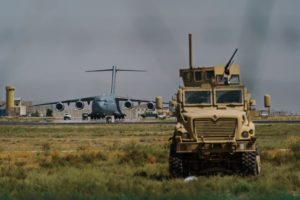No thoughtful observer could in any way believe that the U.S. withdrawal from Afghanistan was anything short of a compilation of purposeful and deadly, as it turns out, blunders on blunders by the Biden national security team – military and diplomatic. Four turning-point bad bungles are described here.

(Photo by Stephanie Keith/Getty Images)
The first blunder was signing up for a get-out-of-Dodge-quick approach with no coordinated military-diplomatic strategic objective. President Biden announced on April 14 that all 2,500 U.S. troops would start a withdrawal from Afghanistan on May 1 and be complete by September 11. The emphasis was on haste and not thoughtful, coordinated, and safe withdrawal of Americans, civilians first and then the military on the ground in Afghanistan. On July 8, no doubt having concluded that the purely political cuteness of the 9/11 date for total evacuation would play negatively, Biden accelerated the complete evacuation timeline to August 31. Keep in mind; he could have extended the date.
There was no rationale for the new date. It was arbitrary and self-imposed. The strategic and sensible approach would have been to establish an operational objective, not a date-certain line in the sand. The national security crowd could have said, “we are leaving Afghanistan starting on May 1 and the mission will be complete when all the American citizens, Afghan nationals wishing to leave, and other foreign nationals that desire to be evacuated have departed. We will then redeploy U.S. forces remaining out of Afghanistan.” That would have put the Taliban on notice and defined successful mission accomplishment. As former U.S. Army Vice Chief of Staff General Jack Keane explained to Maria Bartiromo on Fox News:
“… we said that what the United States policy should be is that we’re going to stay in Afghanistan and get all of our people out, regardless of how long it takes. We’re not leaving until the mission is complete. And that should have been said at the outset. [The] August 31 is President Biden’s self-imposed deadline, which was so ill-conceived it caused all of these problems because there’s no conditions for it.”
The consequence of not starting with a mission objective strategy was to empower the Taliban to use its annual Spring offensive to take over Afghanistan. A second-order effect was to ignore the intelligence that did not support the Biden administration’s narrative that the 300,000 Afghan security troops could stop the Taliban. Besides, it was more important to get out by the deadline.
 The second blunder was to withhold what has been an addiction to close air support to Afghan forces. The U.S. generally does not engage an enemy on the ground without tactical air support from fighters or Reaper drones overhead. Why would we believe the Afghans would do otherwise?
The second blunder was to withhold what has been an addiction to close air support to Afghan forces. The U.S. generally does not engage an enemy on the ground without tactical air support from fighters or Reaper drones overhead. Why would we believe the Afghans would do otherwise?
The idea that the Kabul government’s half-dozen Tucano A-29 light attack aircraft could replace the nearly instant U.S. airpower was ludicrous. Furthermore, the U.S. pulled out the contractor maintenance support, jeopardizing what little airpower the A-29s could provide. The decision to not provide close air support wasn’t made as the Taliban were coming into Kabul on August 15. That decision was made in early June by General Frank McKenzie, the U.S. Central Command combatant commander overseeing the retreat from Afghanistan as he interpreted the commander-in-chief’s direction. As Voice of America’s Carla Babb explained:
“The United States is not planning to support Afghan forces with airstrikes after the US troops withdrawal is complete, and counterterrorism strikes in Afghanistan will be limited to instances when attack plans have been discovered to strike the US homeland or the homelands of our allies, according to the top US commander in the Middle East.”
Without the corner air support drug pusher, the Afghan air-cover-junky realized his time had come and gone. Consequently, Afghan security forces withdrew without engaging the Taliban. This behavior should have been no surprise. When faced with Hellfire missiles and five-hundred-pound laser-guided bombs coming its way, the Taliban has typically disengaged to fight another day. Without the air support, nothing was stopping the Taliban’s advance.

(MARCUS YAM / LOS ANGELES TIMES)
The third blunder was vacating Bagram Air Base. Using both Bagram and the Hamid Karzai International Airport (HKIA) would have provided significantly more capability to evacuate American citizens, Afghan nationals that supported the U.S., and foreign nationals wanting to leave. In addition, both U.S. and allied aircraft could have generated many more sorties into and out of Afghanistan with more ramp space and three runways capable of widebody aircraft versus one. Additionally, the airbase at Bagram had a defensible perimeter by design. Unlike HKIA, where a suicide bomber from ISIS-K made it through Taliban security lines to kill 13 American service members and at least 169 innocent Afghans trying to get through the gate.
Senator Ted Cruz (R-TX), in an August 27 tweet, described the decision to abandon Bagram as political. He said, talking about the chairman of the joint chiefs, Mark Milley:
“What Milley said on 8/18 is exactly what the DOD [Department of Defense] said on our briefing today: They abandoned Bagram because they were ordered to reduce troop levels below that needed to maintain both Bagram & Embassy security. This political decision – to close Bagram BEFORE evacuation – proved catastrophic.”
The fourth blunder was perhaps the most egregious. When the Kabul government collapsed on Sunday, August 15, law and order broke down. Numerous observers reported that armed gangs were moving through the streets. The decision to relinquish the security of Kabul to the Taliban came when a Taliban leader, Abdul Ghani Baradar, described the deteriorating security situation in Kabul. But, again, General McKenzie was at the pointy edge of a very poor decision.
According to Townhall, a quickly convened meeting between General McKenzie and Baradar, leader of the Taliban’s political wing, took place. The article reports that Baradar told McKenzie: “We have a problem. We have two options to deal with it [lawlessness in Kabul]: You [the United States military] take responsibility for securing Kabul, or you have to allow us to do it.”
McKenzie understood his mission to be “only to evacuate American citizens, Afghan allies, and others at risk.” And in a breathtaking moment of intellectual myopia, the general explained that he just needed the airport to do that. “On the spot, an understanding was reached, according to two other US officials: The United States could have the airport until August 31. But the Taliban would control the city.” It probably would have required bringing in more combat troops and more time, maybe, but that was the door Baradar opened. Oh, no, we’ve got to stick to our timeline – pure genius.
Blunders upon blunders tend to compound the magnitude of a potentially disastrous circumstance. So, it was with the U.S. failure to see a strategic objective and exacerbating that failure by taking a narrow, catastrophic view of the problem with a self-imposed time limit. We must expect more from our national security leadership in a dangerous world, but they continue to disappoint.
The views expressed are those of the author and not of any other affiliation.
~
Read more from Dave Patterson.









